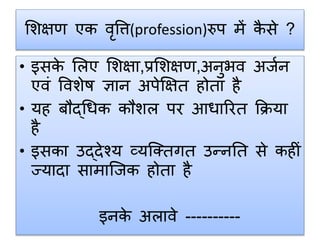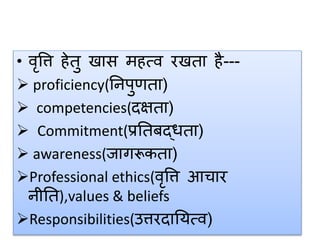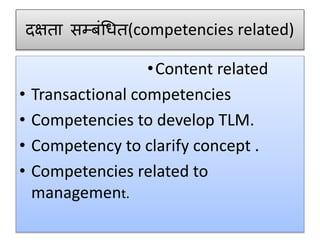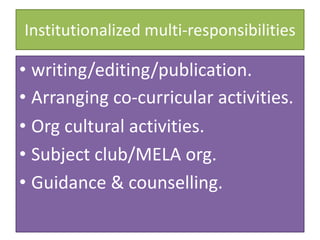৴ড়а§Ха•На§Ја§£ а§Па§Х ৵а•Г১а•Н১ড়(Profession)а§∞а•Б৙ а§Ѓа•За§В а§Ха•Иа§Єа•З
Download as pptx, pdf0 likes755 views
teaching is a profession
1 of 7
Download to read offline







Ad
Recommended
Teaching and training
Teaching and trainingabhisrivastava11
ћэ
Teaching and training ৴ড়а§Ха•На§Ја§£ а§Фа§∞ ৙а•На§∞৴ড়а§Ха•На§Ја§£Relationship between teaching learning
Relationship between teaching learningabhisrivastava11
ћэ
Relationship between teaching learning ৴ড়а§Ха•На§Ја§£ а§Еа§Іа§ња§Ча§Ѓ а§Ха•З а§ђа•Аа§Ъ а§Єа§Ва§ђа§Ва§Іа§Ха§Ња§∞а•На§ѓ ৴ড়а§Ха•На§Ја§Њ (WORK EDUCATION) pushpa mam.pptx
а§Ха§Ња§∞а•На§ѓ ৴ড়а§Ха•На§Ја§Њ (WORK EDUCATION) pushpa mam.pptxSanjayKora1
ћэ
а§Еа§Іа•Нৃৌ৙а§Х ৴ড়а§Ха•На§Ја§Њ а§Ѓа•За§В а§Ха§Ња§∞а•На§ѓ ৴ড়а§Ха•На§Ја§Њ Teaching: Meaning, Definition, Nature, Characteristics and Aims.
Teaching: Meaning, Definition, Nature, Characteristics and Aims.Nishat Anjum
ћэ
Meaning, Definition, Nature, Characteristics and Aims of Teaching in Hindi.Teacher training & Capacity Building Teacher Trai(NEP workshop 2020).pptx
Teacher training & Capacity Building Teacher Trai(NEP workshop 2020).pptxabhisrivastava11
ћэ
Teacher Training, Capacity Building, Outcome-Based Learning, Digital capacity reform, Curriculum Design
Assessment Reforms
Faculty Development
Leverage Technology,NEP workshop 2020 (Teacher Training & )Capacity Building.pptx
NEP workshop 2020 (Teacher Training & )Capacity Building.pptxabhisrivastava11
ћэ
Teacher Training & Capacity Building
outcome based LearningDeterminant of Curriculum By Aditi Tawre
Determinant of Curriculum By Aditi Tawrenaac17
ћэ
for a good curriculum construction we have to understand the determinants which can affect on curriculum. understanding disciplines and subjects.pptx
understanding disciplines and subjects.pptxDiksha Verma
ћэ
Indicators of quality learning
Teaching and learning as interactive process
Major issues in classroom learning; catering individual differences
Learning beyond textbooks- other sources of learning
Curriculum in Commerce
Curriculum in Commerce Diksha Verma
ћэ
Meaning , importance of curriculum.
Principles of curriculum construction.а§Ж৙а§Ха§Њ ৵а•На§ѓа§Ха•Н১ড়১а•Н৵ а§Па§Х ৴ড়а§Ха•На§Ја§Х а§Ха•З а§∞а•В৙ а§Ѓа•За§В а§Ха•Иа§Єа§Њ а§єа•Л?
а§Ж৙а§Ха§Њ ৵а•На§ѓа§Ха•Н১ড়১а•Н৵ а§Па§Х ৴ড়а§Ха•На§Ја§Х а§Ха•З а§∞а•В৙ а§Ѓа•За§В а§Ха•Иа§Єа§Њ а§єа•Л?thinkwithniche
ћэ
а§Ж৙а§Ха§Њ ৵а•На§ѓа§Ха•Н১ড়১а•Н৵ а§Па§Х ৴ড়а§Ха•На§Ја§Х а§Ха•З а§∞а•В৙ а§Ѓа•За§В а§Ха•Иа§Єа§Њ а§єа•Л, а§Па§Х ৴ড়а§Ха•На§Ја§Х а§Ха•А ৙৥৊ৌа§И а§Ча§И а§єа§∞ а§Ъа•Аа§Ь а§Й৮а§Ха•З ৵ড়৶а•На§ѓа§Ња§∞а•Н৕ড়ৃа•Ла§В ৙а§∞ а§Ча§єа§∞а§Њ а§Еа§Єа§∞ а§°а§Ња§≤১а•А а§єа•Иа•§ а§Па§Х а§Еа§Ъа•На§Ыа§Њ а§Фа§∞ ৙а•На§∞а§≠ৌ৵৴ৌа§≤а•А а§Еа§Іа•Нৃৌ৙а§Х ৵৺ а§єа•И а§Ьа•Л ৵ড়৶а•На§ѓа§Ња§∞а•Н৕ড়ৃа•Ла§В, ৙а•На§∞৲ৌ৮ৌ৲а•Нৃৌ৙а§Х ১৕ৌ а§Е৮а•На§ѓ а§Ха•З ৪ৌু৮а•З а§Ха§ња§Єа•А а§≠а•А а§Ча§≤১ ৐ৌ১ а§Ха•З а§≤а§ња§П а§Эа•Ба§Х১ৌ ৮৺а•Аа§В а§єа•Ла•§evolution of social work education in india
evolution of social work education in indiashoibkhan10
ћэ
here are presention about evolution socia work in india. evoluation of social work education in india
evoluation of social work education in indiashoibkhan10
ћэ
presentation about the evoluation of social work education in indiaCO CURRICULAR ACTIVITIES
CO CURRICULAR ACTIVITIESPraseeda2
ћэ
In this small presentation include the definition of co curricular activity,and its definition,objectives of co curricular activity,and also include the principles ,types and importance of co curricular activity৵ড়а§≠ড়৮а•Н৮ а§Еа§Іа§ња§Ча§Ѓ ৪ড়৶а•На§Іа§Ња§В১ а§Фа§∞ а§Й৮а§Ха•З ৮ড়৺ড়১ৌа§∞а•Н৕
৵ড়а§≠ড়৮а•Н৮ а§Еа§Іа§ња§Ча§Ѓ ৪ড়৶а•На§Іа§Ња§В১ а§Фа§∞ а§Й৮а§Ха•З ৮ড়৺ড়১ৌа§∞а•Н৕Dr.Sanjeev Kumar
ћэ
а§Еа§Іа§ња§Ча§Ѓ:৵а•Нৃ৵৺ৌа§∞ ৵৮ৌু а§Єа§Ва§Ьа•На§Юৌ৮ ৴ড়а§Ха•На§Ја§£ а§ѓа•Ла§Ь৮ৌ а§П৵а§В а§За§Єа§Ѓа•За§В ৴ৌুড়а§≤ ১১а•Н৵
৴ড়а§Ха•На§Ја§£ а§ѓа•Ла§Ь৮ৌ а§П৵а§В а§За§Єа§Ѓа•За§В ৴ৌুড়а§≤ ১১а•Н৵Dr.Sanjeev Kumar
ћэ
а§ђа•А .а§Па§° ৙а•На§∞৕ু ৵а§∞а•На§Ј а§Ыৌ১а•На§∞ а§єа•З১а•Б C 3 unit 1 learnng basics
C 3 unit 1 learnng basicsDr.Sanjeev Kumar
ћэ
The document discusses various aspects of learning including definitions, types, processes, domains, levels, taxonomies, and theories. It provides definitions of learning from different scholars such as Gates, Guilford, and Crow & Crow. It lists examples of learning like writing the alphabet, sewing clothes, and translating between languages. It discusses learning as an activity, process, outcome, and habit formation. It also outlines the nature of learning, different types, the cognitive, affective, and psychomotor domains, and Bloom's and Krathwohl and Anderson's taxonomies of learning objectives. Finally, it briefly introduces learning theories and their classification into behavioral and cognitive categories.Barriers to effective communication ppt.
Barriers to effective communication ppt.Dr.Sanjeev Kumar
ћэ
This document discusses barriers to communication in 3 paragraphs. Physiological, social/cultural/ethical, and linguistic barriers are identified. Physiological barriers result from human limitations. Social barriers include conformity, while cultural barriers arise from different group norms. Ethical barriers occur when individuals cannot voice dissent. Linguistic barriers include differences in language, dialect, technical terms, and slang between groups. Overcoming barriers requires considering the receiver, message delivery skills, and feedback.а§Єа§Ѓа•Н৙а•На§∞а•За§Ја§£ ,৙а•На§∞а§≠ৌ৵а•А а§Єа§Ѓа•Н৙а•На§∞а•За§Ја§£ а§Ха•А а§Ж৵৴а•На§ѓа§Х১ৌ
а§Єа§Ѓа•Н৙а•На§∞а•За§Ја§£ ,৙а•На§∞а§≠ৌ৵а•А а§Єа§Ѓа•Н৙а•На§∞а•За§Ја§£ а§Ха•А а§Ж৵৴а•На§ѓа§Х১ৌDr.Sanjeev Kumar
ћэ
communication,needs of effective communicationа§Єа§Ѓа•Н৙а•На§∞а•За§Ја§£ ৙а•На§∞৵ৌ৺ ৵ а§З৮а§Ха•З ৙а•На§∞а§Ха§Ња§∞ Ppt
а§Єа§Ѓа•Н৙а•На§∞а•За§Ја§£ ৙а•На§∞৵ৌ৺ ৵ а§З৮а§Ха•З ৙а•На§∞а§Ха§Ња§∞ PptDr.Sanjeev Kumar
ћэ
useful for Hindi medium M.ED studentFactor affecting learning
Factor affecting learningDr.Sanjeev Kumar
ћэ
There are several key factors that can affect learning:
1) Factors related to the learner themselves, including their physical and mental abilities, potential, health, interests, attitudes, intelligence, prior knowledge, and motivation.
2) Factors related to the teacher, such as their mastery of the subject matter, teaching skills, ability to understand learners, teaching approaches, content selection, organization, linking new concepts to old, balancing theory and practice, providing feedback, and transferring learning.
3) Environmental and working conditions that can impact learning, like the physical environment, socio-emotional climate, facilities, class size, noise levels, schedules, staff coordination, and basic resources.More Related Content
Similar to ৴ড়а§Ха•На§Ја§£ а§Па§Х ৵а•Г১а•Н১ড়(Profession)а§∞а•Б৙ а§Ѓа•За§В а§Ха•Иа§Єа•З (14)
Teacher training & Capacity Building Teacher Trai(NEP workshop 2020).pptx
Teacher training & Capacity Building Teacher Trai(NEP workshop 2020).pptxabhisrivastava11
ћэ
Teacher Training, Capacity Building, Outcome-Based Learning, Digital capacity reform, Curriculum Design
Assessment Reforms
Faculty Development
Leverage Technology,NEP workshop 2020 (Teacher Training & )Capacity Building.pptx
NEP workshop 2020 (Teacher Training & )Capacity Building.pptxabhisrivastava11
ћэ
Teacher Training & Capacity Building
outcome based LearningDeterminant of Curriculum By Aditi Tawre
Determinant of Curriculum By Aditi Tawrenaac17
ћэ
for a good curriculum construction we have to understand the determinants which can affect on curriculum. understanding disciplines and subjects.pptx
understanding disciplines and subjects.pptxDiksha Verma
ћэ
Indicators of quality learning
Teaching and learning as interactive process
Major issues in classroom learning; catering individual differences
Learning beyond textbooks- other sources of learning
Curriculum in Commerce
Curriculum in Commerce Diksha Verma
ћэ
Meaning , importance of curriculum.
Principles of curriculum construction.а§Ж৙а§Ха§Њ ৵а•На§ѓа§Ха•Н১ড়১а•Н৵ а§Па§Х ৴ড়а§Ха•На§Ја§Х а§Ха•З а§∞а•В৙ а§Ѓа•За§В а§Ха•Иа§Єа§Њ а§єа•Л?
а§Ж৙а§Ха§Њ ৵а•На§ѓа§Ха•Н১ড়১а•Н৵ а§Па§Х ৴ড়а§Ха•На§Ја§Х а§Ха•З а§∞а•В৙ а§Ѓа•За§В а§Ха•Иа§Єа§Њ а§єа•Л?thinkwithniche
ћэ
а§Ж৙а§Ха§Њ ৵а•На§ѓа§Ха•Н১ড়১а•Н৵ а§Па§Х ৴ড়а§Ха•На§Ја§Х а§Ха•З а§∞а•В৙ а§Ѓа•За§В а§Ха•Иа§Єа§Њ а§єа•Л, а§Па§Х ৴ড়а§Ха•На§Ја§Х а§Ха•А ৙৥৊ৌа§И а§Ча§И а§єа§∞ а§Ъа•Аа§Ь а§Й৮а§Ха•З ৵ড়৶а•На§ѓа§Ња§∞а•Н৕ড়ৃа•Ла§В ৙а§∞ а§Ча§єа§∞а§Њ а§Еа§Єа§∞ а§°а§Ња§≤১а•А а§єа•Иа•§ а§Па§Х а§Еа§Ъа•На§Ыа§Њ а§Фа§∞ ৙а•На§∞а§≠ৌ৵৴ৌа§≤а•А а§Еа§Іа•Нৃৌ৙а§Х ৵৺ а§єа•И а§Ьа•Л ৵ড়৶а•На§ѓа§Ња§∞а•Н৕ড়ৃа•Ла§В, ৙а•На§∞৲ৌ৮ৌ৲а•Нৃৌ৙а§Х ১৕ৌ а§Е৮а•На§ѓ а§Ха•З ৪ৌু৮а•З а§Ха§ња§Єа•А а§≠а•А а§Ча§≤১ ৐ৌ১ а§Ха•З а§≤а§ња§П а§Эа•Ба§Х১ৌ ৮৺а•Аа§В а§єа•Ла•§evolution of social work education in india
evolution of social work education in indiashoibkhan10
ћэ
here are presention about evolution socia work in india. evoluation of social work education in india
evoluation of social work education in indiashoibkhan10
ћэ
presentation about the evoluation of social work education in indiaCO CURRICULAR ACTIVITIES
CO CURRICULAR ACTIVITIESPraseeda2
ћэ
In this small presentation include the definition of co curricular activity,and its definition,objectives of co curricular activity,and also include the principles ,types and importance of co curricular activityа§Ж৙а§Ха§Њ ৵а•На§ѓа§Ха•Н১ড়১а•Н৵ а§Па§Х ৴ড়а§Ха•На§Ја§Х а§Ха•З а§∞а•В৙ а§Ѓа•За§В а§Ха•Иа§Єа§Њ а§єа•Л?
а§Ж৙а§Ха§Њ ৵а•На§ѓа§Ха•Н১ড়১а•Н৵ а§Па§Х ৴ড়а§Ха•На§Ја§Х а§Ха•З а§∞а•В৙ а§Ѓа•За§В а§Ха•Иа§Єа§Њ а§єа•Л?thinkwithniche
ћэ
More from Dr.Sanjeev Kumar (17)
৵ড়а§≠ড়৮а•Н৮ а§Еа§Іа§ња§Ча§Ѓ ৪ড়৶а•На§Іа§Ња§В১ а§Фа§∞ а§Й৮а§Ха•З ৮ড়৺ড়১ৌа§∞а•Н৕
৵ড়а§≠ড়৮а•Н৮ а§Еа§Іа§ња§Ча§Ѓ ৪ড়৶а•На§Іа§Ња§В১ а§Фа§∞ а§Й৮а§Ха•З ৮ড়৺ড়১ৌа§∞а•Н৕Dr.Sanjeev Kumar
ћэ
а§Еа§Іа§ња§Ча§Ѓ:৵а•Нৃ৵৺ৌа§∞ ৵৮ৌু а§Єа§Ва§Ьа•На§Юৌ৮ ৴ড়а§Ха•На§Ја§£ а§ѓа•Ла§Ь৮ৌ а§П৵а§В а§За§Єа§Ѓа•За§В ৴ৌুড়а§≤ ১১а•Н৵
৴ড়а§Ха•На§Ја§£ а§ѓа•Ла§Ь৮ৌ а§П৵а§В а§За§Єа§Ѓа•За§В ৴ৌুড়а§≤ ১১а•Н৵Dr.Sanjeev Kumar
ћэ
а§ђа•А .а§Па§° ৙а•На§∞৕ু ৵а§∞а•На§Ј а§Ыৌ১а•На§∞ а§єа•З১а•Б C 3 unit 1 learnng basics
C 3 unit 1 learnng basicsDr.Sanjeev Kumar
ћэ
The document discusses various aspects of learning including definitions, types, processes, domains, levels, taxonomies, and theories. It provides definitions of learning from different scholars such as Gates, Guilford, and Crow & Crow. It lists examples of learning like writing the alphabet, sewing clothes, and translating between languages. It discusses learning as an activity, process, outcome, and habit formation. It also outlines the nature of learning, different types, the cognitive, affective, and psychomotor domains, and Bloom's and Krathwohl and Anderson's taxonomies of learning objectives. Finally, it briefly introduces learning theories and their classification into behavioral and cognitive categories.Barriers to effective communication ppt.
Barriers to effective communication ppt.Dr.Sanjeev Kumar
ћэ
This document discusses barriers to communication in 3 paragraphs. Physiological, social/cultural/ethical, and linguistic barriers are identified. Physiological barriers result from human limitations. Social barriers include conformity, while cultural barriers arise from different group norms. Ethical barriers occur when individuals cannot voice dissent. Linguistic barriers include differences in language, dialect, technical terms, and slang between groups. Overcoming barriers requires considering the receiver, message delivery skills, and feedback.а§Єа§Ѓа•Н৙а•На§∞а•За§Ја§£ ,৙а•На§∞а§≠ৌ৵а•А а§Єа§Ѓа•Н৙а•На§∞а•За§Ја§£ а§Ха•А а§Ж৵৴а•На§ѓа§Х১ৌ
а§Єа§Ѓа•Н৙а•На§∞а•За§Ја§£ ,৙а•На§∞а§≠ৌ৵а•А а§Єа§Ѓа•Н৙а•На§∞а•За§Ја§£ а§Ха•А а§Ж৵৴а•На§ѓа§Х১ৌDr.Sanjeev Kumar
ћэ
communication,needs of effective communicationа§Єа§Ѓа•Н৙а•На§∞а•За§Ја§£ ৙а•На§∞৵ৌ৺ ৵ а§З৮а§Ха•З ৙а•На§∞а§Ха§Ња§∞ Ppt
а§Єа§Ѓа•Н৙а•На§∞а•За§Ја§£ ৙а•На§∞৵ৌ৺ ৵ а§З৮а§Ха•З ৙а•На§∞а§Ха§Ња§∞ PptDr.Sanjeev Kumar
ћэ
useful for Hindi medium M.ED studentFactor affecting learning
Factor affecting learningDr.Sanjeev Kumar
ћэ
There are several key factors that can affect learning:
1) Factors related to the learner themselves, including their physical and mental abilities, potential, health, interests, attitudes, intelligence, prior knowledge, and motivation.
2) Factors related to the teacher, such as their mastery of the subject matter, teaching skills, ability to understand learners, teaching approaches, content selection, organization, linking new concepts to old, balancing theory and practice, providing feedback, and transferring learning.
3) Environmental and working conditions that can impact learning, like the physical environment, socio-emotional climate, facilities, class size, noise levels, schedules, staff coordination, and basic resources.Motivation and learning ppt
Motivation and learning pptDr.Sanjeev Kumar
ћэ
Motivation is driven by the need to maintain energy balance. All behavior requires energy expenditure. A hungry man walks further to find food, a student studies longer for an exam, and a father works more hours to pay for his son's education, all due to motivation. Motivation can be intrinsic or extrinsic. It is difficult to directly observe but is evident through sustained energy, persistence and variability in behavior. Teachers can motivate students using techniques like rewards and praise, competition and cooperation, emphasizing success, and providing models. The key is focusing on goals, encouraging positive motives, and creating a supportive learning environment.৴ড়а§Ха•На§Ја§£ а§Па§Х ৵а•Г১а•Н১ড়(Profession)а§∞а•Б৙ а§Ѓа•За§В а§Ха•Иа§Єа•З
৴ড়а§Ха•На§Ја§£ а§Па§Х ৵а•Г১а•Н১ড়(Profession)а§∞а•Б৙ а§Ѓа•За§В а§Ха•Иа§Єа•ЗDr.Sanjeev Kumar
ћэ
ppt very useful for hindi medium B.Ed studentsMeaning of goals ,aims and objectives
Meaning of goals ,aims and objectivesDr.Sanjeev Kumar
ћэ
Goals and aims are broad terms that are achievable over the long term. Goals are more specific than aims. Objectives are specific statements of actions that will result in observable changes in learners. The aim of education is the all-round development of individuals so they can contribute to society. Goals, such as becoming a teacher, doctor, or engineer, are ways individuals can work toward the broad aim of social reform. Objectives, like gaining subject competence and understanding pedagogy, are the specific steps needed to achieve a goal like becoming a good teacher. Aims are very broad and comprehensive, informed by philosophy and societal expectations, while objectives are narrower and specific steps informed by psychology to guide learners approaches &strategies of teaching
approaches &strategies of teachingDr.Sanjeev Kumar
ћэ
The document discusses different approaches to learning and teaching, including teacher-centered vs learner-centered, and teacher-controlled vs learner-controlled vs group-controlled. It outlines strategies for each approach, such as lecture and demonstration for teacher-centered autocratic strategies, and group discussion/debate for learner-centered democratic strategies. Learning experiences are defined as those that positively shape behavior, and can be provided through formal curricular and co-curricular activities. Expository and inquiry approaches are also discussed, along with strategies for each like lecture and discussion for expository and concept formation for inquiry.а§Еа§Іа§ња§Ча§Ѓ а§Фа§∞ а§Еа§Іа§ња§Ча§Ѓ ৪ড়৶а•На§Іа§Ња§В১
а§Еа§Іа§ња§Ча§Ѓ а§Фа§∞ а§Еа§Іа§ња§Ча§Ѓ ৪ড়৶а•На§Іа§Ња§В১Dr.Sanjeev Kumar
ћэ
ppt useful for hindi medium B.Ed students৴ড়а§Ха•На§Ја§£ а§П৵а§В а§Еа§Іа§ња§Ча§Ѓ а§Ха§Њ а§Єа§Ѓа•Н৐৮а•На§І
৴ড়а§Ха•На§Ја§£ а§П৵а§В а§Еа§Іа§ња§Ча§Ѓ а§Ха§Њ а§Єа§Ѓа•Н৐৮а•На§ІDr.Sanjeev Kumar
ћэ
Powerpoint presentation usefulfor hindi medium B.Ed students৴ড়а§Ха•На§Ја§£ а§Ха•На§ѓа§Њ
৴ড়а§Ха•На§Ја§£ а§Ха•На§ѓа§ЊDr.Sanjeev Kumar
ћэ
This ppt is very useful for hindi medium B.Ed students.а§Еа§Іа§ња§Ча§Ѓ а§Фа§∞ а§Еа§Іа§ња§Ча§Ѓ ৪ড়৶а•На§Іа§Ња§В১
а§Еа§Іа§ња§Ча§Ѓ а§Фа§∞ а§Еа§Іа§ња§Ча§Ѓ ৪ড়৶а•На§Іа§Ња§В১Dr.Sanjeev Kumar
ћэ
৙а•На§∞а§Єа•Н১а•Б১ а§Єа•На§≤а§Ња§За§° а§Еа§Іа§ња§Ча§Ѓ а§Єа§ња§Іа•На§єа§В১а•Ла§В а§єа•З১а•Б а§Й৙ৃа•Ла§Ча•А а§єа•Ла§Ва§Ча•А ৵ড়а§≠ড়৮а•Н৮ а§Еа§Іа§ња§Ча§Ѓ ৪ড়৶а•На§Іа§Ња§В১ а§Фа§∞ а§Й৮а§Ха•З ৮ড়৺ড়১ৌа§∞а•Н৕
৵ড়а§≠ড়৮а•Н৮ а§Еа§Іа§ња§Ча§Ѓ ৪ড়৶а•На§Іа§Ња§В১ а§Фа§∞ а§Й৮а§Ха•З ৮ড়৺ড়১ৌа§∞а•Н৕Dr.Sanjeev Kumar
ћэ
৴ড়а§Ха•На§Ја§£ а§ѓа•Ла§Ь৮ৌ а§П৵а§В а§За§Єа§Ѓа•За§В ৴ৌুড়а§≤ ১১а•Н৵
৴ড়а§Ха•На§Ја§£ а§ѓа•Ла§Ь৮ৌ а§П৵а§В а§За§Єа§Ѓа•За§В ৴ৌুড়а§≤ ১১а•Н৵Dr.Sanjeev Kumar
ћэ
а§Єа§Ѓа•Н৙а•На§∞а•За§Ја§£ ,৙а•На§∞а§≠ৌ৵а•А а§Єа§Ѓа•Н৙а•На§∞а•За§Ја§£ а§Ха•А а§Ж৵৴а•На§ѓа§Х১ৌ
а§Єа§Ѓа•Н৙а•На§∞а•За§Ја§£ ,৙а•На§∞а§≠ৌ৵а•А а§Єа§Ѓа•Н৙а•На§∞а•За§Ја§£ а§Ха•А а§Ж৵৴а•На§ѓа§Х১ৌDr.Sanjeev Kumar
ћэ
а§Єа§Ѓа•Н৙а•На§∞а•За§Ја§£ ৙а•На§∞৵ৌ৺ ৵ а§З৮а§Ха•З ৙а•На§∞а§Ха§Ња§∞ Ppt
а§Єа§Ѓа•Н৙а•На§∞а•За§Ја§£ ৙а•На§∞৵ৌ৺ ৵ а§З৮а§Ха•З ৙а•На§∞а§Ха§Ња§∞ PptDr.Sanjeev Kumar
ћэ
৴ড়а§Ха•На§Ја§£ а§Па§Х ৵а•Г১а•Н১ড়(Profession)а§∞а•Б৙ а§Ѓа•За§В а§Ха•Иа§Єа•З
৴ড়а§Ха•На§Ја§£ а§Па§Х ৵а•Г১а•Н১ড়(Profession)а§∞а•Б৙ а§Ѓа•За§В а§Ха•Иа§Єа•ЗDr.Sanjeev Kumar
ћэ
Ad
৴ড়а§Ха•На§Ја§£ а§Па§Х ৵а•Г১а•Н১ড়(Profession)а§∞а•Б৙ а§Ѓа•За§В а§Ха•Иа§Єа•З
- 1. ৴ড়а§Ха•На§Ја§£ а§Па§Х ৵а•Г১а•Н১ড়(profession)а§∞а•Б৙ а§Ѓа•За§В а§Ха•И а§Єа•З ? вАҐ а§За§Єа§Ха•З ৴ড়а§П ৴ড়а§Ха•На§Ја§Њ,৙а•На§∞৴ড়а§Ха•На§Ја§£,а§Е৮а•Ба§≠৵ а§Еа§∞а•На§Ь৮ а§П৵а§В ১а•Н১৵ড়а•За§Ј а§Ьа•На§Юৌ৮ а§Е৙а•За§Ха•На§Ја§Ха•Нৣ১ а§єа•Л১ৌ а§єа•И вАҐ а§ѓа§є а§ђа•М৶а•На§Іа§ња§Х а§Ха•Ма§ња§њ ৙а§∞ а§Жа§ња§Ња§∞а§∞১ а§Ха•На§∞а§ња§ѓа§Њ а§єа•И вАҐ а§За§Єа§Ха§Њ а§Й৶а•Н৶а•З৴а•На§ѓ ৵а•На§ѓа§Ха•Н১১а§Ч১ а§Й৮а•Н৮১১ а§Єа•З а§Ха§є а§В а§Ьа•Нৃৌ৶ৌ а§Єа§Ња§Ѓа§Ња§Ха•На§∞а•На§Х а§єа•Л১ৌ а§єа•И а§З৮а§Ха•З а§Еড়ৌ৵а•З ----------
- 2. вАҐ ৵а•Г১а•Н১ড় а§єа•З১а•Б а§Ца§Ња§Є ু৺১а•Н৵ а§∞а§Ц১ৌ а§єа•И--- пГШ proficiency(১৮৙а•Ба§£а§§а§Њ) пГШ competencies(৶а§Ха•Нৣ১ৌ) пГШ Commitment(৙а•На§∞১১৐৶а•Нড়১ৌ) пГШ awareness(а§∞а•На§Ња§Ча§∞а•Ва§Х১ৌ) пГШProfessional ethics(৵а•Г১а•Н১ড় а§Жа§Ъа§Ња§∞ ৮а•А১১),values & beliefs пГШResponsibilities(а§Йа§ња§∞৶ৌ১ৃ১а•Н৵)
- 3. Professional ethics &Values related(а§Ѓа•Ва§≤а•На§ѓ а§Єа§Ѓа•На§ђа§В৲ড়১) вАҐ ুৌ৮৵а•Аа§ѓ а§Ѓа•Ва§≤а•На§ѓа•Ла§В а§Ха§Њ ৙ৌড়৮ ৪১а•Нৃ১৮ৣа•Н৆ৌ,а§Иুৌ৮৶ৌа§∞ ,৙а§∞а•Л৙а§Ха§Ња§∞ а§Ж৶৶ вАҐ ৪ু১ৌ ৵ ৙а§Ха•Нৣ৙ৌ১ а§∞৶৺১ ৵а•Нৃ৵৺ৌа§∞ вАҐ ুৌ৮৵ৌ৲ড়а§Ха§Ња§∞ ,а§ђа§Ња§њ а§Еа§Іа§ња§Ха§Ња§∞ а§Ха•З ৙а•На§∞১১ а§Єа§Ъа•З১১ৌ вАҐ ৙а•На§∞а§∞а•Нৌ১ৌа§Ха•Н৮а•На§ња§Х а§Ѓа•Ва§≤а•На§ѓа•Ла§В ৙а§∞ а§Іа•Нৃৌ৮ вАҐ а§Х১а§Ь৵а•Нৃ৙а§∞а§Ња§ѓа§£ ৵ ৪ুৃ১৮ৣа•Н৆ вАҐ ৵а•Г১а•Н১ড় а§Ха•З ৙а•На§∞১১ а§Єа§Ха§Ња§∞ৌ১а•На§Ѓа§Х а§Єа•Ла§Ва§Ъ
- 4. вАҐ а§Ѓа§Ња§Іа•Нৃ৴ুа§Х ৴ড়а§Ха•На§Ја§Њ а§Жа§ѓа•Ла§Ч(1952)а§Ха•З а§ња§ђа•Н৶а•Ла§В а§Ѓа•За§ВвАФ вАЬ৴ড়а§Ха•На§Ја§Х а§Е৙৮а•З а§Ха§Ња§ѓа§Ь а§Ха•Л а§∞а•На•А৵а§Ха•Л৙ৌа§∞а•На§Ь৮ а§Ха§Њ а§Еа§∞а•Ба§Іа§Ъа§Ха§∞ ৪ৌড়৮ ৮৺ а§В а§Єа§Ѓа§Эа•За§Ва§Ча•З ,৵а§∞৮ а§Йа§Єа•З а§Єа§Ѓа§Ња§∞а•На§Єа•З৵ৌ а§Ха§∞৮а•З а§Ха§Њ а§Па§Х ু৺১а•Н৵৙а•Ва§£а§Ь а§Ѓа§Ња§Ча§Ь а§Єа§Ѓа§Эа•За§Ва§Ча•З,৪ৌ৕ а§є а§Йа§Єа•З а§Ж১а•Нু৴৪৶а•На§Іа§њ а§П৵а§В а§Ж১а•Нুৌ৴а§≠৵а•На§ѓа§Ха•Н১১ а§Ха§Њ а§Й৙ৌৃ а§Єа§Ѓа§Эа•За§Ва§Ча•З|вАЭ
- 5. ৶а§Ха•Нৣ১ৌ а§Єа§Ѓа•На§ђа§В৲ড়১(competencies related) вАҐContent related вАҐ Transactional competencies вАҐ Competencies to develop TLM. вАҐ Competency to clarify concept . вАҐ Competencies related to management.
- 6. Commitment related(৙а•На§∞১১৐৶а•Нড়১ৌ а§Єа§Ѓа•На§ђа§В৲ড়১) пГЉCommitment to society.(а§Єа§Ѓа§Ња§∞а•Н а§Ха•З ৙а•На§∞১১ ৙а•На§∞১১৐৶а•Нড়১ৌ ) пГЉCommitment to Learner.(а§Еа§Іа•На§ѓа•З১ৌ а§Ха•З ৙а•На§∞১১ ৙а•На§∞১১৐৶а•Нড়১ৌ) пГЉCommitment to basic value.а§Жа§ња§Ња§∞ а§Ѓа•Ва§≤а•На§ѓа•Ла§В а§Ха•З ৙а•На§∞১১ ৙а•На§∞১১৐৶а•Нড়১ৌ) пГЉCommitment to the profession.(৵а•Г১а•Н১ড়а§Х ৙а•На§∞১১৐৶а•Нড়১ৌ)
- 7. Institutionalized multi-responsibilities вАҐ writing/editing/publication. вАҐ Arranging co-curricular activities. вАҐ Org cultural activities. вАҐ Subject club/MELA org. вАҐ Guidance & counselling.